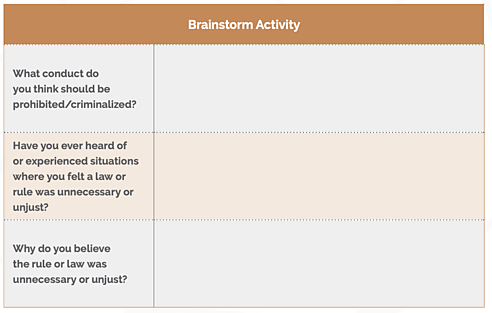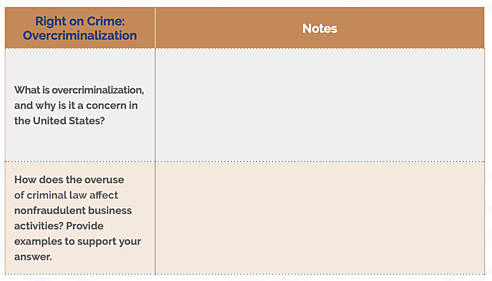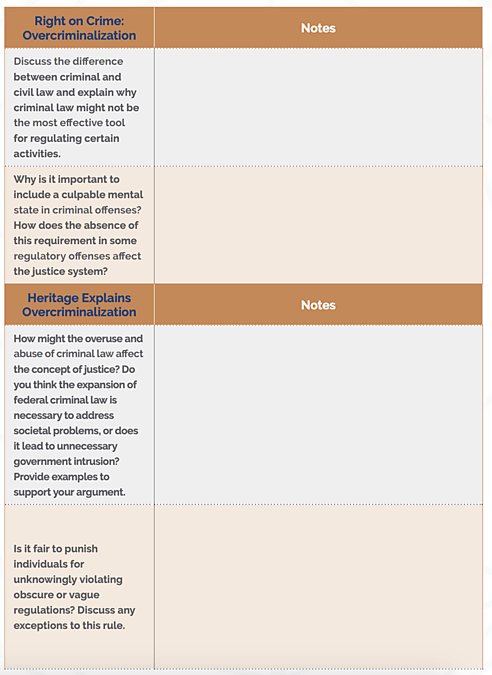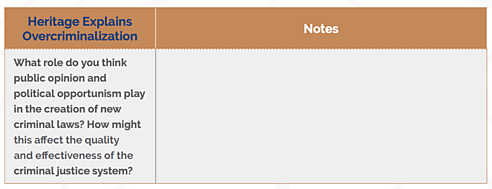Objectives
- Understand the concept of overcriminalization
- Analyze the impact of overcriminalization on society
- Evaluate potential solutions to address overcriminalization
Step 1: Ask students why they think conduct should be prohibited or criminalized. Then ask if they have ever heard of or experienced situations where they felt a law or rule was unnecessary or unjust. Pass out the graphic organizer handout and have students record their answers.
Step 2: Define criminal offenses.
Step 3: Project or write a list of common behaviors or activities that are criminal offenses.
Step 4: Facilitate a brief discussion about student responses.
Activity 1: Podcast Reflection (About 20 Minutes)
Step 1: Listen to Cato Daily Podcast’s “Cataloging the Myriad Ways You Can Land in Jail” episode. Encourage students to take notes on the graphic organizer during the podcast and answer reflection questions.
Step 2: Facilitate a brief discussion after the podcast
Activity 2: Article Analysis (About 30 Minutes)
Step 1: Explain to students that they will read three articles on overcriminalization and that they should take notes and answer the questions to help understand the complexity of the issue.
Step 2: Have students read the following three articles in the graphic organizer handout that provide a brief explanation of overcriminalization. Ask students to record their notes and answers to the questions. Share with them that they need to be prepared to share their responses with classmates.
Optional Break Point for Splitting Lesson into Two Days Depending on If Block Is 55 Minutes or 1.5 Hours
Activity 3: Research on Current Laws (About 20 Minutes)
Step 1: Assign students to groups of three or four.
Step 2: Ask students how many criminal laws they think exist. Then move on to the next step after they generate answers to share out as a class.
Step 3: Task each group with research on current laws or actions that they would like to remove or decriminalize and have them prepare a multimedia presentation to persuade lawmakers why the laws should be changed.
Exit Ticket (About 5 Minutes)
Students should sketch or create a diagram to demonstrate understanding of the relationship between public opinion and increased criminal laws.
Activity 1: Local Case Review
Step 1: Ask students to individually research and find an example of overcriminalization in their local community or in the news.
Step 2: Instruct them to write a short paragraph explaining the case and its implications.
Step 3: If time allows, ask students to share their findings with the class and facilitate a brief discussion.
Activity 2: Case Summary: Sessions v. Dimaya
Step 1: Read Justice Gorsuch on Overcriminalization and Arbitrary Prosecution and Case Summary: Sessions v. Dimaya.
Step 2: Create a list of criminal offenses that might be affected by this ruling.
James Dimaya, a lawful permanent resident from the Philippines, was convicted of two residential burglary charges in California. Based on these convictions, the government sought to deport him under the Immigration and Nationality Act (INA) provision that classified burglary as a crime of violence. The provision defined a crime of violence as any offense that involved a substantial risk of physical force against another person or property.
Dimaya challenged the constitutionality of the INA provision, arguing that it was unconstitutionally vague and violated his due process rights under the Fifth Amendment. The case made its way to the US Supreme Court after going through lower courts.
In a 5–4 decision, the Supreme Court held that the INA provision was unconstitutionally vague. Justice Elena Kagan delivered the opinion of the Court, joined by Justices Ruth Bader Ginsburg, Stephen Breyer, Sonia Sotomayor, and Neil Gorsuch. The Court found that the provision failed to provide clear guidance on what crimes qualified as crimes of violence, leaving it up to the courts to determine on a case‐by‐case basis. This lack of clarity violated the due process rights of noncitizens, as it did not give them fair notice of what conduct would subject them to deportation.
The Supreme Court’s decision in Sessions v. Dimaya had significant implications for immigration law and the rights of noncitizens. By striking down the vague provision in the INA, the Court provided greater clarity and protection for noncitizens facing deportation. The decision also highlighted the importance of ensuring that laws are clear and specific, especially when they involve the potential deprivation of liberty.
At the beginning of class, individually brainstorm and record your response to the following questions.

After discussing the brainstorming questions with a partner and listening to your classmates’ responses, consider the following questions while listening to the Cato Daily Podcast episode “Cataloging the Myriad Ways You Can Land in Jail.”

Read the following three articles that provide a brief explanation of overcriminalization, recording your notes and answers to the questions below. Be prepared to share your responses with your classmates.



Now that you’ve explored multiple perspectives on overcriminalization, please create a sketch or diagram that shows your understanding of the relationship between public opinion and increased criminal laws.